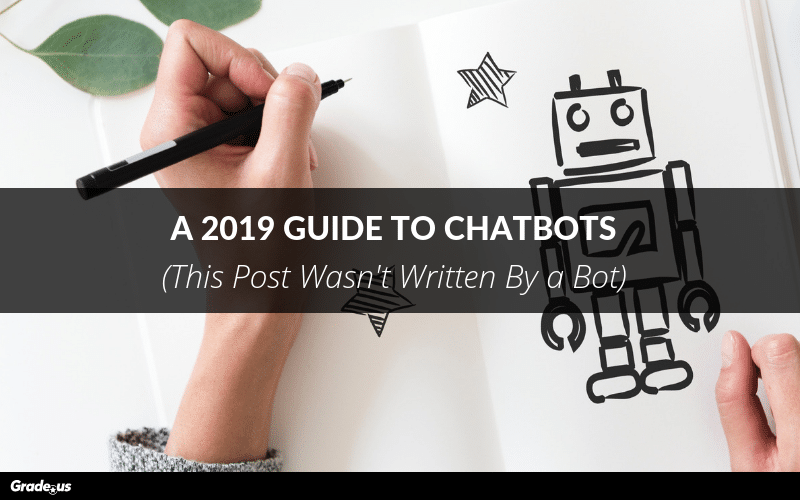Hey, great news! You don't have to read another "what's hot in marketing in 2019" post.
Why, you ask? Because I can pretty much sum it up in one word: chatbots.
They're at the forefront of everyone's mind right now, and if you aren't using them already, they need to be at the top of your company's marketing agenda.
Meet the Chatbots
When a chatbot is done correctly, you'll know you're talking to a bot. But you might not care.
Today's bots are friendly, conversational, personable, and capable of understanding a wide range of queries.
Of course, like all computers, they're only as good as their programming.
A Few Chatbot Examples
You'll find this lovely chatbot on a certain website you may be visiting right now.

Hi, little guy! Why do you look so familiar? It must be because you look just a little bit like William Shatner. Do you find you get that a lot?
Here's the Bot from 1-800-Flowers, named one of the Top 5 bots by botsociety.io.

I don't have to make any decisions? Sign me up.
Right away you can see how this bot saves time: instead of spending 20 minutes combing through unsuitable options on the webpage, you can just enter your criteria and get some suggestions.
As you can see, many customers will be able to get through the whole process without ever talking to another human being. 1-800-Flowers estimates 70% of the orders they got through this chat bot were new orders.
And the bot isn't even perfect. I managed to confuse it once or twice. I wasn't even trying to do it. Nevertheless, it was good enough to drive a whole lot of new revenue and to build loyalty with lots of new customers.
Why You Might Need Chatbots
Most people born after 1977 are pretty comfortable talking to our new robot overlords. In some cases we'd rather do that than talk to a human.
Talking to humans means getting put on hold. It also means carving out time to focus exclusively on this stranger we're supposed to be talking to. It means we can't do it on the bus, the train, the plane, the restaurant.
We can do all that when we're quickly texting or typing to a bot, all while feeling we can get through the interaction without having to dig to get our questions asked.
1. 85% of all the transactions that take place in the near-future will happen without the intervention of any human being. AI-human interaction is expected and welcomed, so long as the AI is making itself useful.
2. Customers want their specific questions answered, and yesterday. Some customers aren't even content to click off to read your FAQ to find their answers anymore. They want to be able to ask their question or make their purchase and get on with their lives.
3. Bots don't need to eat, take smoke breaks, sleep, take sick days, get paid, or have health insurance. They are hard at work even when you and the rest of your team can't be.
Bots are most useful as sales, customer service, and tech support tools. But chatbots are more likely to change these functions than they are to replace them.
- Chatbots can handle some of the work of pre-qualifying leads, so your sales team can spend less time doing that or cold prospecting and may instead spend the majority of their time with high-value leads who are likely to convert.
- Customer service pros can spend less time growing bored and frustrated as they answer the same twenty questions day-in-and-day-out. Instead, they can seek to join conversations on social media or spend their time solving the most challenging customer problems.
- Your tech support person will sing your praises when she can spend her time solving challenging problems instead of spending their days with people who don’t know to try clearing the cache or rebooting.
Thus, chatbots can be the key to more meaningful work, which is the key to employee recruitment and retention.
You can even stop tracking foolish call center metrics like, "How fast did Joe Service get Jane Customer off the phone," and instead track metrics like, "How satisfied are Joe Service's customers when they get off the phone with him?"
Customer satisfaction should be the goal, after all, even if successful service means Joe spends an hour talking to the same guy because the problem's just that sticky.
Where You'll Use Chatbots
There are two primary places you'll use chatbots.
The first is on your website. Your chatbot should be up and running any time you don't have a real live human ready to chat with customers.
The second is on private messaging functions on your primary social channels. You can add bots to Facebook, Twitter, and LinkedIn chats.
Where you invest time and effort into designing and implementing your bots will depend entirely on where your customers are. If you never interact with your target customer on LinkedIn you probably don't need to add a chatbot there, either.
How You'll Get Chatbots
Good news: you don't have to be a programmer to design or implement a chatbot. Which is good, because you're going to want to create your own.
There are a whole lot of chatbot apps out there designed to make the process easy for you.
Here are a few to get you started.
Several of these programs can help you design chatbots for a whole bunch of different platforms at once, such as your website, Facebook, and Twitter direct message.
If you're interested in setting up live chat instead of an automated solution, here's some great live chat software solutions to review.
Chatbot Best Practices
The full list of best practices could make an entire article all by themselves, but these are the five that strike me as the most important.
Approach chatbot design as if it is content design
There are a lot of similarities. You have to think about what your customer might want to do or know. You have to think up answers to those questions and write them.
You might need to go to the same stakeholders (sales, customer service, tech support) to ask what questions they get day-in-and-day-out.
You'll probably need some sort of map or flowchart to keep track of it all, just like your content marketing efforts need a good content audit and an editorial calendar.
If you don't make an effort to include most of what a customer needs or wants to know you'll limit the bot's effectiveness.
Think about including slang variants and other bits of conversational language so the bot doesn't get confused
I managed to trip up the 1-800-Flowers bot twice by typing things it didn't expect. The first was me jumping right in with telling it, "I want to buy a gift for Grandma."
Did not compute. The thing just sort of stopped in its tracks, and I couldn't even get it back to the beginning of the chain.
I feel like it should have been programmed with all sorts of common "I want to buy a gift" phrases, and I feel like it should have kicked me directly into the gift selection process at that point.
The second time I tripped up the bot it asked me how much I wanted the gift to cost. I typed $30.
Turns out it assumed I wouldn't put the $ in, so it said, "Okay, a $$30 gift." It didn't look like a huge problem until I got to the end of the process. The bot hadn't selected anything.
I went and checked: they do have a few items for less than $30. I can only conclude the doubled dollar sign was the issue, but lots of people are going to make that mistake. And if the issue is it somehow couldn't find anything at that price point, a little message to let me know would have been helpful, instead of a blank return.
I'm not picking on 1-800-Flowers, by the way. Obviously their chatbot does a good job. I'm just trying to demonstrate some of the things you'll want to anticipate when you design yours. Easy enough to program $30 and $$30 to lead to the same responses.
Put in some pre-generated options
A customer can read options on a messenger bot very quickly. It's not the same thing as the dreadful automated phone menu the chatbot will probably replace for good.
This is also a nice way around trying to think of the twenty different ways people might express they're trying to buy a gift for Grandmother. If customers start talking and see, "Ask a question," "Track an order," and "Buy a gift" right away, there's no guesswork about what phrasing the bot will understand.
They just pick "buy a gift," and the bot is free to move them to the next step. Note 1-800-Flowers does this, but they did it deeper into the process than I would have expected. I wanted to talk buying a gift right away, and it wanted to ease me into the process a bit.
But then, I'm even less into small talk than your average robot, apparently!
Give the little dude a name and a personality
Like any polite person, your bot should introduce himself or herself before the conversation begins. That means he or she has to have a name in the first place.
You should also pick a tone for your bot. Something that matches your company. If you sell high-end luxury cars you probably wouldn't use language like "little dude," for example. If you sell video games, you might.
For the most part, we're happy to talk to bots as long as they admit they're bots but act a little bit human. Stiff, boring robots aren't much fun to deal with.
The Pitfalls You'll Need to Avoid
Remember when we all used to get pissed about talking to robots? You know the ones I mean. The ones that told you to press "3" for billing or to enter your four million digit account number followed by the pound sign?
Those old telephone bots are pretty much the prime example of "what not to do" with a chatbot. And some companies are making some of the same mistakes.
Making these mistakes won't save the customer's experience, even if your Bot is really funny and cute.
1. Your bot's menu items don't offer access to everything a customer might need or want to talk about.
2. Your bot isn't very smart, so it has trouble getting customers where they need to go.
3. Your bot never offers an obvious way to get the customer over to a human being.
4. Your bot has an unpleasant personality, or no personality at all.
Be sure to test your bot before you take it live so you can see what the user experience will look like.
People are pretty used to interacting with an AI online, and for the most part it doesn't bug them the way it bugs them over the phone. But that doesn't mean a poorly designed chatbot won't suck all the value from your efforts.
How about you?
Will you be implementing or improving a chatbot this year?
Have you used chatbots in the past? Have you seen some serious success with them?
Have you gained any insights I missed?
If so, let us know in the comments below!
About the Author
Raney C. Hudson
Raney C. Hudson is an independent content consultant with a 10+ year track record in the digital marketing industry.











